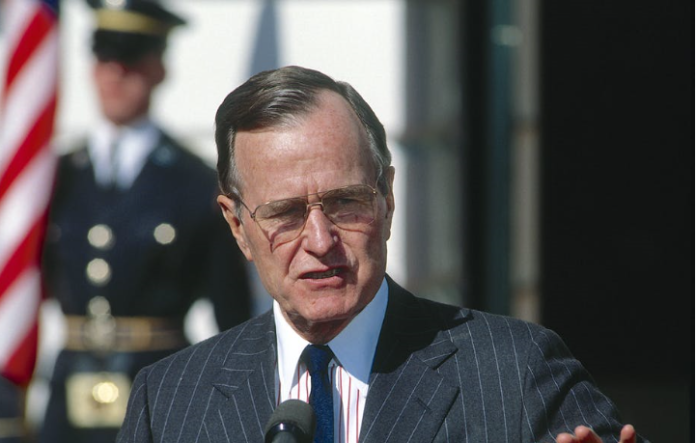
Jack Schneider, University of Massachusetts Lowell
George H.W. Bush fulfilled his desire – articulated late in his 1988 campaign for president – to be “the education president.” It just took three decades.
It’s true that Bush passed no education bills during his one term as president.
His next three successors, by contrast, all produced signature education legislation: Goals 2000 for Bill Clinton, No Child Left Behind for George W. Bush and both Race to the Top and the Every Student Succeeds Act for Barack Obama. All, however, followed a plan drawn up by George H.W. Bush. He was – in my view as an education historian – the architect of sweeping change.
The cornerstone of the Bush education blueprint was an elite bipartisan consensus. Like his predecessor in the White House – Ronald Reagan – Bush was sympathetic to the free market. But unlike Reagan, Bush was a pragmatist, and as vice president had watched Reagan fail in his push for tuition vouchers. But Bush was also a consummate Washington insider, less intent on dismantling government than on improving it. In the long wake of the alarmist A Nation at Risk report, which suggested that American students were falling behind their international peers, Bush offered a new vision for federal involvement in education. Rather than choosing between the unregulated market and the heavy hand of government to fix schools, Bush offered a third way, making the case that entrepreneurial activity in education should be encouraged and carefully monitored by the state. That vision, which shaped an entire generation of education reformers, remains the foundation of an enduring consensus among liberals and conservatives alike.
Federal government as catalyst
Beyond establishing a vision, Bush threw his energies into school reform projects large and small. In keeping with his belief that the federal government could “serve as a catalyst” in promoting change, he was an early advocate for charter schools, which he successfully framed as a bipartisan marriage of entrepreneurism and government, and which he pitched not as devices of the free market, but as an experimentation against inequality. Through the New American Schools Development Corporation, for instance, Bush funded the Community Learning Centers of Minnesota project – the first endeavor “based on the charter school concept, a variation of the school choice approach.” In so doing, he created a model that would be replicated a thousand times over.
Perhaps most significantly, Bush laid the foundation for standards-based accountability. Before he took office, the federal government had little involvement in the governance of public schools. President Lyndon Johnson had increased Washington’s reach through the Elementary and Secondary Education Act of 1965, which channeled vast new sums to schools. But Johnson and his successors – including Jimmy Carter, who elevated the Department of Education to the Cabinet – had done little to position the federal government as a kind of executive suite in public education. Bush changed that, and sought to do so by developing top-down accountability through curricular standards and aligned tests.
Less than a year after taking office, the Bush administration worked with the National Governors’ Association to organize the 1989 Charlottesville education summit – a meeting at which then-Arkansas Governor Bill Clinton distinguished himself as an ally. A few short months later, in his 1990 State of the Union address, Bush proposed his America 2000 legislation, which called for standardized tests that would “tell parents and educators, politicians, and employers just how well our schools are doing.”
Enduring influence
At the time he was defeated in his bid for reelection, Bush had little to show for his plans. The charter sector in the early 1990s remained minuscule. Congress sank America 2000 shortly after it was proposed.
Over time, however, Bush’s grand design was gradually realized. Rechristening Bush’s failed America 2000 legislation as Goals 2000, Bill Clinton gave incentives to states to create curricular standards and aligned tests, and he doled out millions of dollars in grants to charter school developers. George W. Bush advanced his father’s work through No Child Left Behind, as well as through strong support for the charter sector, which doubled in size under his administration. Barack Obama offered continued support to the charter sector, while also ensuring the future of accountability testing through Every Student Succeeds Act. In short, the Bush paradigm has had remarkable endurance across time and across different administrations.
This is not to say that federal policy has had a positive effect on schools over the past quarter-century. No Child Left Behind is today viewed by policy experts, educators and even many of its original backers as a failure. And charter schools, despite receiving generally positive press, have produced mixed results while largely failing to produce real innovation.
Nevertheless, the endurance of these efforts reveals Bush’s particular genius for working within complex democratic bureaucracies to build lasting power. The Department of Education, once a sleepy backwater, today exercises tremendous influence. And in wielding that influence, Bush’s successors – both Republicans and Democrats – have also advanced his administrative agenda. Phrases like “standards and accountability” and “school choice,” once deployed only by policy wonks, are now common terms in the national education dialogue.
George H.W. Bush’s ideas persisted well after he left office. That’s because they were rooted in compromise between elites on both sides of the aisle and because they were patiently developed through bureaucratic institutions and the law. For good or ill, it seems, true power lies not in the issuance of ideological proclamations or executive orders – it lies in statecraft. Leaders, after all, may come and go. But their policies can continue to shape the world long after they leave office.![]()
Jack Schneider, Assistant Professor of Education, University of Massachusetts Lowell
This article is republished from The Conversation under a Creative Commons license. Read the original article.




















